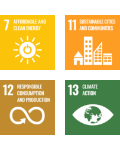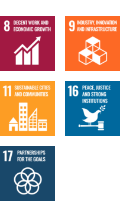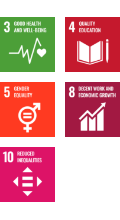| Material Issues |
Key Success Factors (KSF) |
Action for 2030 Targets |
| Key Goal Indicators (KGI for 2030) |
Initiatives |
Consolidated |
Key Performance Indicators (KPI for 2030) |
|
Realize an environmentally sustainable society

|
Address climate change
|
Achieve carbon zero in 2030 |
Management conscious of GHG emission reduction (visualization of Scope 1 and 2) |
✓ |
Reduce GHG emissions by 40% from FY 2021 level |
| Use eco-friendly vehicles for sales (EV, HV) |
✓ |
Use eco-friendly cars (next-generation vehicles such as EVs and FCVs): 100% |
| Green procurement (active use of eco-products) |
|
In-house procured products conforming to the Eco Mark and Act on Promoting Green Procurement: 100% |
| Environmental protection and supply chain |
Switch to eco-friendly products: 100% |
Conduct investigations of contained chemical substances and declare non-use of conflict minerals |
✓ |
Appropriately implement the Group's environmental protection policies and declarations |
| Conduct environmental due diligence of suppliers |
✓ |
Continuously manage group-wide environmental DD surveys |
| Create green businesses and conserve biodiversity |
Improve green business rate |
Shift from selling products to providing services (service-based business model) |
✓ |
Achieve a sales composition ratio of at least 50% for subscriptions in the business security
|
| Provide energy-saving products (semiconductors, circuit design, and systems) |
Achieve a sales composition ratio of at least 50% for energy-saving and regenerative E-field devices |
| Propose products for the renewable energy field |
|
| Introduce environmentally conscious businesses (products and services) |
✓ |
Reduce packaging materials by 30% by improving eco-packaging ratio (compared to fiscal 2023) |
| Respond to natural disasters |
Create BCP businesses |
Provide useful services during disasters |
|
Commercialize smart office solutions |
| BCP measures |
|
Formulate BCPs for each risk |
|
Realize a society full of kindness

|
Provide a safe, secure, and comfortable business environment |
Elevate customer trust |
Propose a safe and comfortable office |
✓ |
Sales from loyal customers: 80%% |
| Launch products into new technology businesses |
| Introduce businesses using AI |
| Provide products useful for daily life |
Provide safe and secure products and improve customer satisfaction |
Offer products in pursuit of comfort |
✓ |
Improve customer satisfaction scores |
| Propose more efficient store management and safety |
| Enhance value-added services |
Increase the ratio of service businesses |
Propose solutions for customer product development |
| Provide high-quality products and services |
| Build a framework of cooperation with government and industry associations |
Cooperate with government and industry associations for a sustainable society (number of cases/year) |
Partner with Japan Association of Electronic Article Surveillance Machines (JEAS) and National Shoplifting Prevention Organization |
|
Continue support for JEAS and improve partnership |
| Provide safety and security in local communities through partnerships with local governments |
|
Promote initiatives with local governments and industry associations |
|
Employee self-realization and DEI promotion

|
Improve employee engagement |
Continue to achieve an average employee awareness survey target of at least 4.5 points |
Provide diverse working styles and places |
|
Establish frameworks for a side job system and a four-day workweek
Receive an HR Award |
| Improve employee engagement |
|
Continue to achieve an average employee awareness survey target of at least 4.5 points |
| Promote in-house DX |
Build in-house IT systems that incorporate new technologies |
Promote the integration of the use of AI, RPA, and ERP, and formulate rules |
✓ |
Implement and operate IT strategies incorporating new technologies |
| Make use of reskilling |
Create new business models |
Acquire new knowledge through a wide variety of e-learning |
✓ |
Implement new technology training
Annual training expenses: 40M, target employee 40% |
| Promote the creation and development of new technologies, products, and business models |
|
Exchange rate of personnel with business partners, ventures, NPOs, research institutes, etc.: 5%; Use of side job system: 30% |
| Improve (develop) the working environment |
Creating a workplace where Employees employees can work healthily and with high motivation |
Enhancing HR and Labor Systems |
✓ |
Enhance employee motivation and provide a safe work environment |
| Promoting health and productivity management |
|
Obtain "Certified Health & Productivity Management Outstanding Organizations" and continuouly operate it |
| Promote DEI |
Raise the ratio of female, non-Japanese, and mid-career in managerial positions |
Systematically increase the ratio of female, non-Japanese, and mid-career employees in managerial positions |
|
Women: 30%, non-Japanese: 3%, mid-career: 30% |
| Increase the rate of male employees taking childcare leave |
|
Continuation by male employees: 100% |
|
Strengthen the governance system and improve transparency

|
Raise awareness of compliance |
Earn recognition as an honest company |
Enhance compliance education |
✓ |
Ensure the thoroughness of regular education and enhance operation management |
| Strengthen the TK Group's governance system |
✓ |
Robust group governance system and continuous management |
| Strengthen risk response capabilities |
Build an integrated risk management system for the TK Group |
Strengthen the TK Group's risk management system |
✓ |
Ensure comprehensive risk coverage and enhance group management |
| Develop an understanding of overseas local risks, and educate and protect employees |
✓ |
Formulate protection rules and enhance employee education |
| Strengthen the cybersecurity management system (IT-BCP) |
✓ |
Continuously operate a robust cybersecurity system that can respond to changes |
| Establish a risk management system in the supply chain (especially supplier management) |
✓ |
Appropriately operate the supply chain management system according to social conditions and trends |
| Respect for human rights and supply chain |
Achieve recognition as a company that values human rights through its supply chain |
Supplier human rights due diligence |
✓ |
Properly implement human rights policies in accordance with international standards |
| Strengthen management transparency |
Continue to issue integrated reports |
Prepare and proactively disclose ESG data and integrated reports |
✓ |
Enhance ESG data |
| Diversify the management team |
Strengthen diversity |
Recruit female directors and allocate human resources with diverse capabilities |
|
Female directors: 30% |